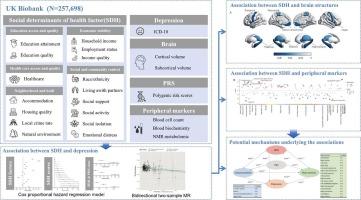抑郁症中健康、大脑结构和免疫代谢机制的社会决定因素:来自英国生物银行的多组学分析。
IF 7.6
2区 医学
Q1 IMMUNOLOGY
引用次数: 0
摘要
背景:抑郁症是一个主要的全球健康挑战,然而健康的社会决定因素(SDH)在形成抑郁症风险中的作用-特别是通过潜在的生物学机制-仍然没有得到充分的了解。本研究利用多组学方法来探索不利的社会条件如何通过神经和生理途径影响抑郁症。方法:利用来自英国生物银行257,698名参与者的数据。采用Cox比例风险回归模型检验SDH、多基因风险评分(PRS)和抑郁之间的关系。相关分析探讨SDH、生物标志物、大脑结构和抑郁之间的关系。双样本孟德尔随机化(MR)被用于研究因果关系,而结构方程模型(SEM)被用于研究SDH、抑郁症、大脑结构、PRS和免疫代谢生物标志物之间的相互作用。结果:抑郁与SDH显著相关。多变量Cox回归显示,不良SDH会增加抑郁风险(HR = 1.916),较高的PRS也与抑郁风险增加相关(HR = 1.288)。不良SDH和高PRS的组合产生最高的抑郁风险(HR = 2.578)。MR分析进一步强调不良SDH与抑郁之间的因果关系。SDH还与大脑结构变化和代谢标志物有关,在不利的SDH组中,海马和岛等区域的脑容量较小,同时与甘油三酯和c反应蛋白等生物标志物有关。扫描电镜分析显示SDH通过免疫代谢和脑结构途径影响抑郁。结论:这些发现强调了抑郁症的多面性,强调了社会劣势是如何通过遗传和生理机制在生物学上嵌入的。解决SDH的关键可改变成分可能是有针对性预防的有力策略,特别是在遗传风险人群中。本文章由计算机程序翻译,如有差异,请以英文原文为准。

Social determinants of health, brain structure, and immune-metabolic mechanisms in depression: A multi-omic analysis from the UK Biobank
Background
Depression is a leading global health challenge, yet the role of Social Determinants of Health (SDH) in shaping depression risk − particularly through underlying biological mechanisms − remains insufficiently understood. This study leverages a multi-omics approach to explore how unfavorable social conditions influence depression through neural, and physiological pathways.
Methods
Drawing on data from 257,698 participants in the UK Biobank. Cox proportional hazards regression models were used to examine the relationship between SDH, polygenic risk scores (PRS), and depression. Correlation analyses were conducted to explore associations between SDH, biomarkers, brain structure, and depression. Two-sample mendelian randomization (MR) was applied to investigate causal relationships, while structural equation modeling (SEM) was used to examine interactions among SDH, depression, brain structure, PRS, and immune-metabolic biomarkers.
Results
Depression was significantly associated with SDH. Multivariable Cox regression showed that unfavorable SDH increased depression risk (HR = 1.916), and higher PRS was also linked to increased risk (HR = 1.288). The combination of unfavorable SDH and high PRS yielded the highest depression risk (HR = 2.578). MR analysis further emphasized the causal relationship between unfavorable SDH and depression. SDH was also linked to brain structural changes and metabolic markers, with smaller brain volumes in regions like the hippocampus and insula in the unfavorable SDH group, along with associations with biomarkers such as triglycerides and C-reactive protein. SEM analysis revealed that SDH influenced depression through immune-metabolic and brain structural pathways.
Conclusions
These findings underscore the multifaceted nature of depression, highlighting how social disadvantage becomes biologically embedded through genetic and physiological mechanisms. Addressing key modifiable components of SDH may represent a powerful strategy for targeted prevention, especially in genetically at-risk populations.
求助全文
通过发布文献求助,成功后即可免费获取论文全文。
去求助
来源期刊
CiteScore
29.60
自引率
2.00%
发文量
290
审稿时长
28 days
期刊介绍:
Established in 1987, Brain, Behavior, and Immunity proudly serves as the official journal of the Psychoneuroimmunology Research Society (PNIRS). This pioneering journal is dedicated to publishing peer-reviewed basic, experimental, and clinical studies that explore the intricate interactions among behavioral, neural, endocrine, and immune systems in both humans and animals.
As an international and interdisciplinary platform, Brain, Behavior, and Immunity focuses on original research spanning neuroscience, immunology, integrative physiology, behavioral biology, psychiatry, psychology, and clinical medicine. The journal is inclusive of research conducted at various levels, including molecular, cellular, social, and whole organism perspectives. With a commitment to efficiency, the journal facilitates online submission and review, ensuring timely publication of experimental results. Manuscripts typically undergo peer review and are returned to authors within 30 days of submission. It's worth noting that Brain, Behavior, and Immunity, published eight times a year, does not impose submission fees or page charges, fostering an open and accessible platform for scientific discourse.

 求助内容:
求助内容: 应助结果提醒方式:
应助结果提醒方式:


